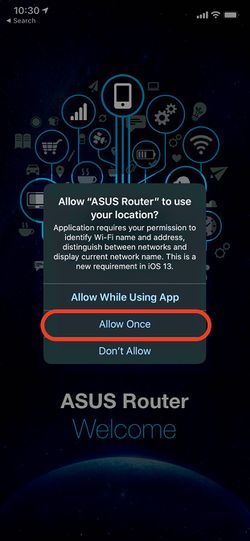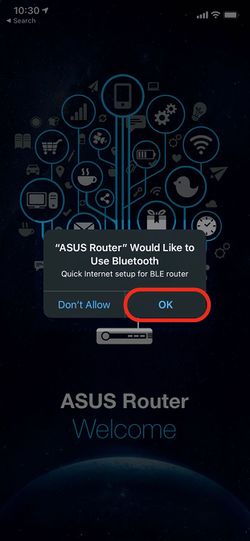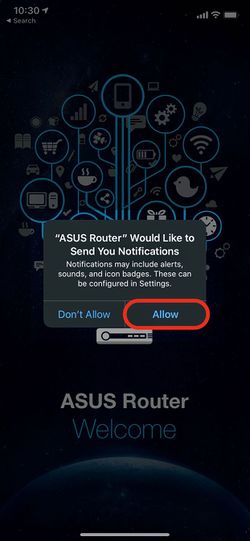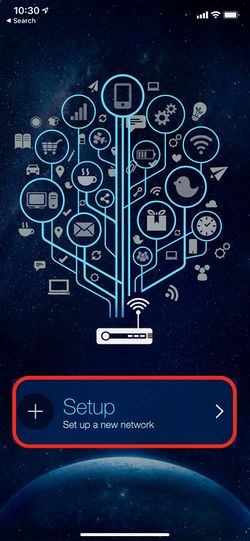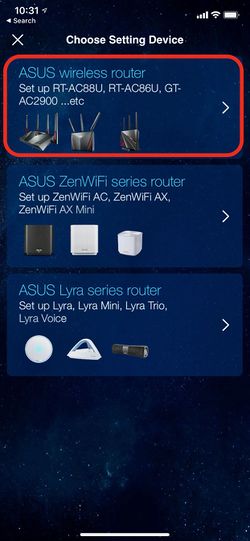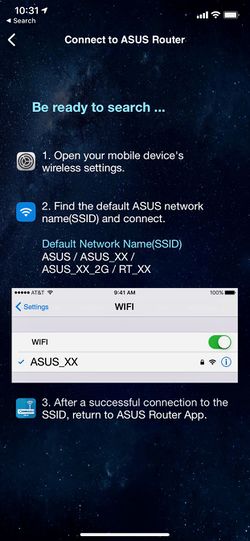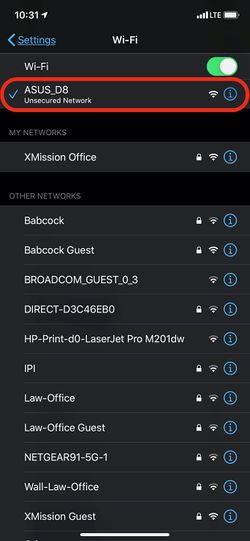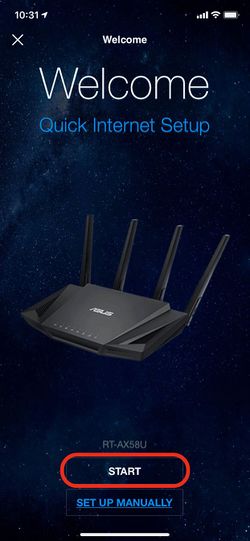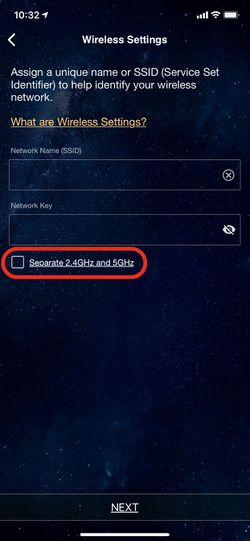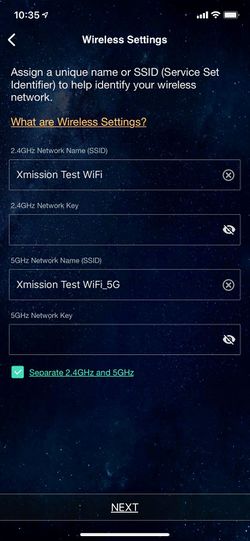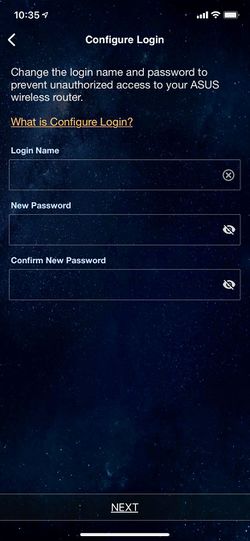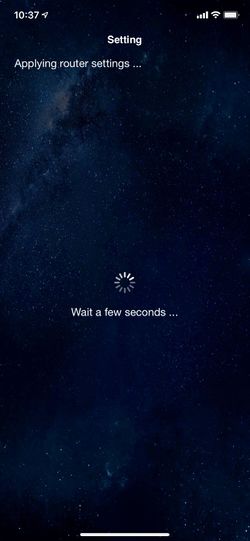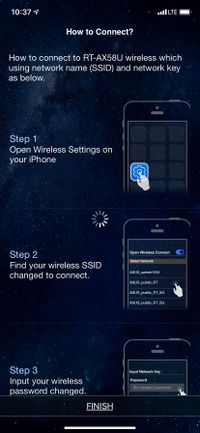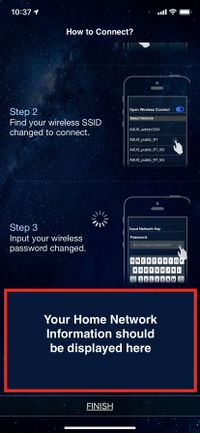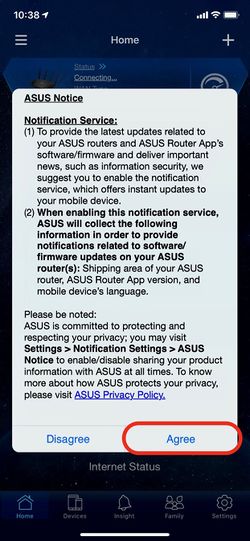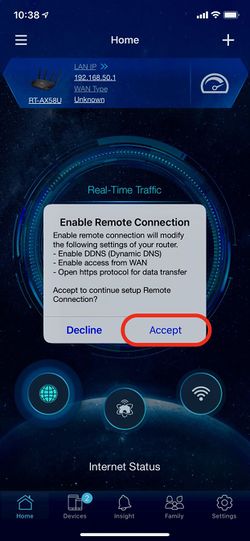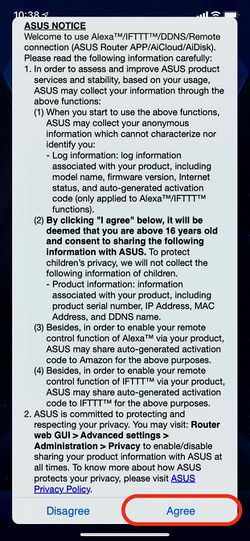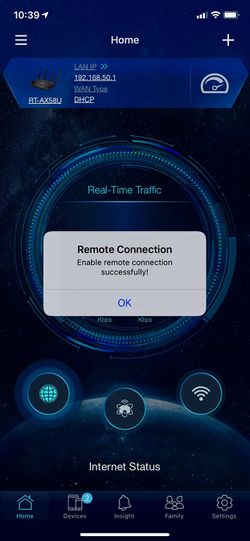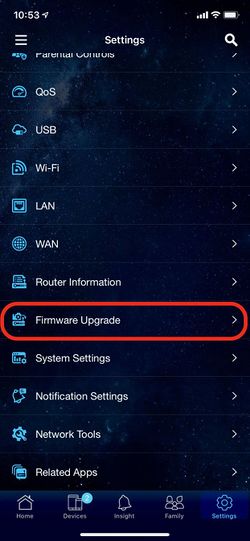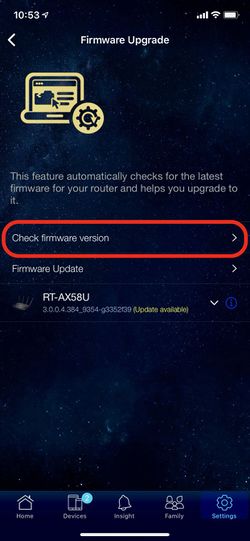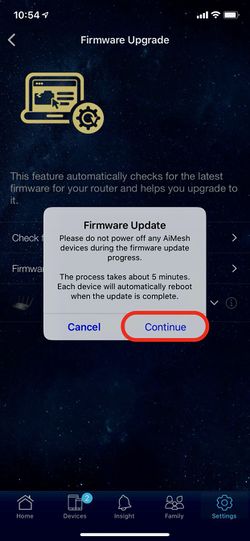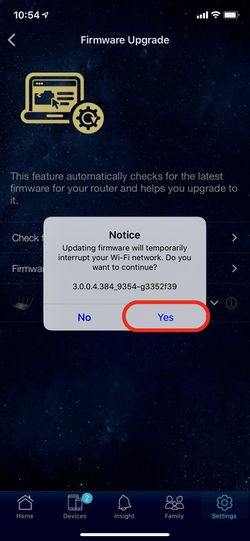Recommended Routers/Asus Routers: Difference between revisions
| (3 intermediate revisions by the same user not shown) | |||
| Line 1: | Line 1: | ||
<pre style="color:blue"> | <pre style="color:blue"> | ||
! Important | |||
* This help page applies to most all Asus Routers, please consult your routers manual to determine if the Asus Router App is compatible with your model. | * This help page applies to most all Asus Routers, please consult your routers manual to determine if the Asus Router App is compatible with your model. | ||
* All Gigabit Asus routers should be supported on the XMission/UTOPIA Network. | * All Gigabit Asus routers should be supported on the XMission/UTOPIA Network. | ||
| Line 61: | Line 61: | ||
|- style="vertical-align:top;" | |- style="vertical-align:top;" | ||
| style="width: 300px;padding:5px;" | <small> Once you App has connected to the new router you will nee to tap "START". </small> | | style="width: 300px;padding:5px;" | <small> Once you App has connected to the new router you will nee to tap "START". </small> | ||
| style="width: 300px;padding:5px;" | <small> ASUS will auto detect the type of Internet connection you have with XMission. (Residential connections are defaulted DHCP or Plug-n-Play).</small> | | style="width: 300px;padding:5px;" | <small> ASUS will auto detect the type of Internet connection you have with XMission. <br> (Residential connections are defaulted DHCP or Plug-n-Play).</small> | ||
| style="width: 300px;padding:5px;" | <small> We suggest separating the 2.4GHz an 5GHz radio signals. Having them combined can often cause wireless issues. </small> | | style="width: 300px;padding:5px;" | <small> We suggest separating the 2.4GHz an 5GHz radio signals. Having them combined can often cause wireless issues. </small> | ||
| style="width: 300px;padding:5px;" | <small> The Network Name (SSID) is the name that you'll find when trying to connect new devices to your home network. The Network Key is the | | style="width: 300px;padding:5px;" | <small> The Network Name (SSID) is the name that you'll find when trying to connect new devices to your home network. The Network Key is the password used to connect those devices. </small> | ||
|} | |} | ||
{| | {| | ||
| Line 103: | Line 103: | ||
|} | |} | ||
== Wireless Optimizing == | |||
While XMission cannot guarantee advertised speeds over wireless Internet, there are things you can to to optimize your Wireless internet. This can help with getting better Wireless Speeds. | |||
=== WiFi Analyzer === | |||
Wireless routers have quickly become an essential appliance in the modern home. Use of a Wifi Analyzer, to optimize your WiFi network may become required. | |||
Depending on your home situation it is common that the wireless channel being used has become overcrowded. Using a wireless channel that is overcrowded can decreased bandwidth and/or connectivity issues for your network. Use Wifi Analyzer to see what channels are in use and to identify the best channel to set on your router. | |||
Please visit our [https://wiki.xmission.com/WiFi_Analyzer WiFi Analyzer] page for assistance. | |||
== Troubleshooting == | |||
[https://wiki.xmission.com/Router_and_Wireless_Troubleshooting Common Troubleshooting] | |||
=== Speed Tests === | |||
Running speed tests are a great way to determine if you have a connectivity issue, however, there are a number of factors that can dramatically affect the results of your tests. | |||
For help with speed tests please [[Speedtest | visit]] | |||
* It is not recommended to use the speed test function built into the router interface. This speed test function does not test a server with-in the northern region of Utah and will often produce slower results. | |||
* Please use [http://speedtest.xmission.com/ XMission's Speed test] or [https://www.speedtest.net/ Ookla] any other speed test service can not be verified. | |||
* For Window 10 and Mac users we strongly suggest installing the [https://www.speedtest.net/apps Ookla App] to get the most accurate results. | |||
=== Wireless Speeds === | |||
Please be aware that internet speeds are limited on wireless networking, XMission can not troubleshoot speed issues basied on wireless results alone. It will be required to have a device hardwired to your router using a Cat5e Ethernet Cable. | |||
Common Wireless Speeds are: | |||
* 2.4GHz typically only supports Wireless speeds of 10-75Mbps. | |||
* 5GHz typically supports wireless speeds of 10-600/1000Mbps. | |||
[[Category: Troubleshooting]] | [[Category: Troubleshooting]] | ||
[[Category: UTOPIA]] | [[Category: UTOPIA]] | ||
[[Category: UTOPIA | [[Category: UTOPIA Troubleshooting]] | ||
Latest revision as of 08:52, 24 June 2020
! Important * This help page applies to most all Asus Routers, please consult your routers manual to determine if the Asus Router App is compatible with your model. * All Gigabit Asus routers should be supported on the XMission/UTOPIA Network. * Our testing is done in a business set up with high interference cause by; brick/metal walls, large electronic equipment and networking equipment. * Your interaction with this device or other Asus products may differ than ours based on your home configuration and placement of the Router.
ASUS
- Our in-house testing was completed on the ASUS RT-AX3000 v3 model.
- XMission has verified that this device supports internet speeds up to 1Gbps over Ethernet Connections, Wireless speeds averaged between 50-500Mbps.
AX3000 Dual Band WiFi 6 (802.11ax) Router supporting MU-MIMO and OFDMA technology, with AiProtection Pro network security powered by Trend Micro™. AX3000 supports 160MHz bandwidth and 1024-QAM for dramatically faster wireless connections. With a total networking speed of up-to 1000Mbps. Compatible with ASUS AiMesh WiFi system for seamless whole-home coverage.
ASUS Router App
Notice: Please be aware that ASUS encourages you to use a computer to set up and manage your home network. Most router models will also support setup via smartphone App, in our example we uses the App.
Access your Smart Phone's App Store and search for the ASUS Router App or * iOS Apple devices * Android devices
Open App
The first time you access the App you will need to authorize usage to your smart device.
Router Set-up
Personalize your WiFi
Asus App Add-ons
Firmware
Wireless Optimizing
While XMission cannot guarantee advertised speeds over wireless Internet, there are things you can to to optimize your Wireless internet. This can help with getting better Wireless Speeds.
WiFi Analyzer
Wireless routers have quickly become an essential appliance in the modern home. Use of a Wifi Analyzer, to optimize your WiFi network may become required.
Depending on your home situation it is common that the wireless channel being used has become overcrowded. Using a wireless channel that is overcrowded can decreased bandwidth and/or connectivity issues for your network. Use Wifi Analyzer to see what channels are in use and to identify the best channel to set on your router.
Please visit our WiFi Analyzer page for assistance.
Troubleshooting
Speed Tests
Running speed tests are a great way to determine if you have a connectivity issue, however, there are a number of factors that can dramatically affect the results of your tests.
For help with speed tests please visit
- It is not recommended to use the speed test function built into the router interface. This speed test function does not test a server with-in the northern region of Utah and will often produce slower results.
- Please use XMission's Speed test or Ookla any other speed test service can not be verified.
- For Window 10 and Mac users we strongly suggest installing the Ookla App to get the most accurate results.
Wireless Speeds
Please be aware that internet speeds are limited on wireless networking, XMission can not troubleshoot speed issues basied on wireless results alone. It will be required to have a device hardwired to your router using a Cat5e Ethernet Cable.
Common Wireless Speeds are: * 2.4GHz typically only supports Wireless speeds of 10-75Mbps. * 5GHz typically supports wireless speeds of 10-600/1000Mbps.
